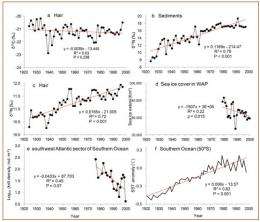Changes in krill abundance inferred from antarctic fur seal

It is possible to know a tree from its fruit, but is it possible to know a prey from its predator? The answer is YES with Antarctic krill and Antarctic fur seals. Scientists of the University of Science and Technology of China (USTC) detected changes in the number of krill from the hair of seals.
A team of researchers led by Prof. SUN Liguang from the Institute of Polar Environment, School of Earth and Space Sciences of USTC, inferred the relative krill population changes along the West Antarctic Peninsula (WAP) over the 20th century by analyzing the shift in δ15N of seal hair. And it was proposed that the local declining relative krill abundance over the past century is caused by the recent rapid regional (RRR) warming and sea ice receding.
Antarctic krill Euphausia superba is a predominant species in the Southern Ocean. Though small in size, it affects the survival of many species in Antarctic marine ecosystems as it constitutes the major source of food for them. Supporting a large number of fishes, seabirds, seals and whales, krill plays a vital role in the sustainable development of Antarctic marine ecosystems. The modern krill stocks have been estimated directly by net hauls and acoustic surveys; the historical krill density especially the long-term one in the Southern Ocean, however, is still unknown. The findings of the team led by Prof. SUN unprecedentedly filled the gap.
But how to infer the change of Krill Abundance from a fine and slender seal hair? It was introduced by Prof. SUN that Antarctic fur seals feed preferentially on krill, and their trophic level (indicated by δ15N) is controlled by their dietary compositions. Therefore, a shift in δ15N of seal hair indicates a change in the proportion of krill in the seal' s diet, which further reflects the krill availability in the local seawater. SUN' s team performed stable isotope analyses on an Antarctic fur seal hair series which "aged" more than 100 years, reconstructed fur seal trophic level variability and inferred the relative changes in krill abundance. The results support an overall decreasing trend for Antarctic krill abundance during the past century, which is agreement with direct observation for the past 30 years.
As a cold water zooplankton, Antarctic krill is very sensitive to ocean climate change. By comparing the krill abundance change with the regional sea surface temperature and local sea ice extent, SUN and his colleagues consider the recent regional warming climate as the likely factor for the declining krill abundance in the 20th century.
In fact, no reliable method has been found so far in studying the population changes of species living in ocean over time. The novel method created by Prof. SUN, therefore, opens a new road in the field of exploring the relationship between krill population changes and the climate changes the Antarctic Oceans.
More information: Huang T, Sun L, Stark J, Wang Y, Cheng Z, et al. (2011) Relative Changes in Krill Abundance Inferred from Antarctic Fur Seal. PLoS ONE 6(11): e27331. doi:10.1371/journal.pone.0027331
Journal information: PLoS ONE
Provided by Chinese Academy of Sciences
















